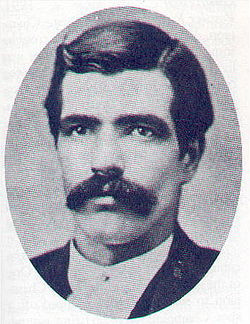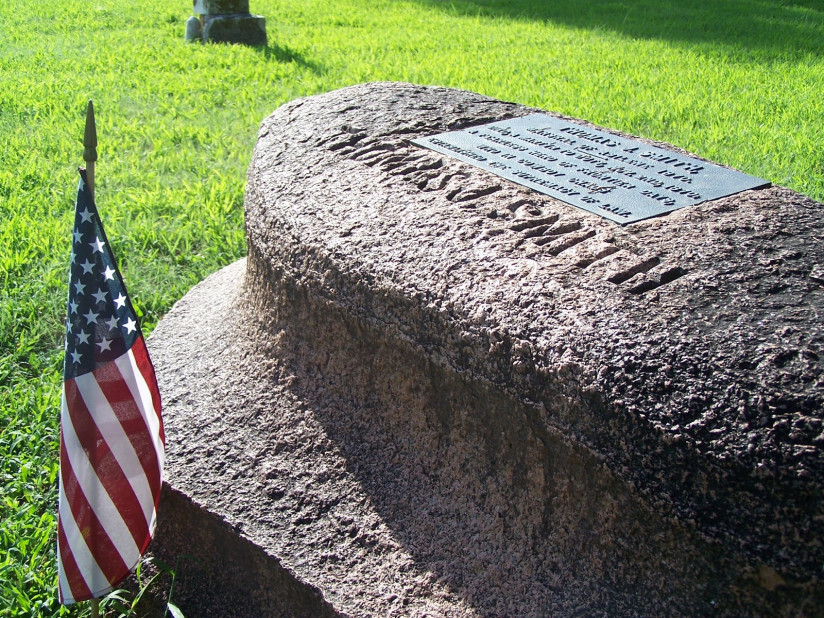Tom Smith: The Marshal Who Fought with his Fists
"Bear River" Thomas James Smith was born around 1830 in New York. We do not know his birth date for certain since records have not been found. This can be a fairly common problem when researching individuals that lived so long ago, but even today, many people do not write things down or save personal records or diaries. According to an 1870 census though, Smith was listed as being 40 years old, so that is where we get his birth year.
 Smith worked in law enforcement in quite a few different states before coming to Abilene, Kansas. He was an officer of the law in New York, Colorado, and Wyoming. He was also known to be quite a boxer, which is a skill he would put into great use while enforcing the law in the roughneck town of Abilene. Smith earned his nickname "Bear River" while serving as a lawman in Bear River City, Wyoming. In the town, a group of armed men killed an employee of the railroad because they claimed the man was guilty of murder. This led to several railroad workers attacking the group of armed men in retaliation. A massive fight occurred between the two groups, and much of the town was destroyed by fire. Smith being on neither side, defended himself and other townspeople from the massive attacks. This went on for several days until troops from Fort Bridger were able to respond to the problem and stop both groups. It is not exactly clear what Smith did during all of this, but he gained renown for the event.
Smith worked in law enforcement in quite a few different states before coming to Abilene, Kansas. He was an officer of the law in New York, Colorado, and Wyoming. He was also known to be quite a boxer, which is a skill he would put into great use while enforcing the law in the roughneck town of Abilene. Smith earned his nickname "Bear River" while serving as a lawman in Bear River City, Wyoming. In the town, a group of armed men killed an employee of the railroad because they claimed the man was guilty of murder. This led to several railroad workers attacking the group of armed men in retaliation. A massive fight occurred between the two groups, and much of the town was destroyed by fire. Smith being on neither side, defended himself and other townspeople from the massive attacks. This went on for several days until troops from Fort Bridger were able to respond to the problem and stop both groups. It is not exactly clear what Smith did during all of this, but he gained renown for the event.
Smith was hired as Abilene's chief of police on June 4, 1870 by Mayor T.C. Henry (who would later gain a reputation as the "Wheat King" of Dickinson County). It is important to understand what Abilene was like before Smith was hired though. Abilene was definitely a dangerous town at the time, one could even call it a "sin city." When Joseph McCoy built the Great Western stockyards in Abilene in 1867, effectively turning the town into a cattle shipping railhead, the town mostly consisted of sod homes and dugouts. Three years had passed and much had changed. Abilene became a town of transients for most of the year. When cowboys arrived in Abilene, they had been on the trail for three months. They were ready to come back to society. These cowboys were accustomed to maintaining a strict discipline while on the trail, because if they did not, cattle could be lost, or someone could be injured or killed. So when they arrived in Abilene, they were ready to let off some steam. The cowboys were paid their wages once the cattle were delivered, and generally, they spent the cash like wildfire. They would get a haircut, clean themselves up, and buy new clothes. After that, it was time to hit the saloons, where they could drink and gamble their money away. Or in some cases, the cowboys would visit one of the brothels and spend their money on a "lady of the night." If all of this was not enough, violence was common as well. Fights over poker games would occur. Sure, most of these fights were likely just fistfights, but most of these cowboys were wearing six-shooters on their sides, so shootouts could occur. That said, generally speaking, most of the gunfire that could be heard on Texas Street in Abilene was cowboys shooting at signs and other objects; but nevertheless, Abilene was a dangerous town to reside in.
After all of this, it was time for Abilene to have some law enforcement. First off, two men from St. Louis were hired to clean up the town. As the story goes, these two men were so intimidated by the crime in Abilene, that they quit before they even finished a day of duty.
Getting back to Tom Smith being hired as chief of police on June 4, 1870... His initial pay was $150 a month and $2 for every conviction he made. Here is an interesting fact, Smith was only hired to be in this position for one month. However, he stayed on until his death that fall. Smith received a raise in August, so he must have been doing a good job.
What did Smith do though? Well first off, he enforced a "no firearms ordinance." With this law, everyone arriving in Abilene was required to check in their firearm with the proprietor of the hotel they were staying in. Smith himself did not use a firearm much either. He was known to use his fists when apprehending lawbreakers. With Smith, it was definitely more common to see him punch someone in the face than see him draw a weapon. Smith was capable using a firearm when necessary though, he just did not see the need when apprehending many criminals. Another event that Smith received praise for was closing down the red light district. In the Abilene Chronicle, September 8, 1870, it states that Smith told the "vile characters" to "close their dens--or suffer the consequences." According to the article, all of the "houses of ill fame" quickly closed down and the women involved in that work left town shortly after.
Probably the most well-known story concerning Smith is his death. What is most surprising about his death is that it occurred by the hands of two farmers rather than cowboys. In late October, a local farmer named Andrew McConnell had an argument with his neighbor John Shea. Shea had been driving his cattle across McConnell's land, McConnell unhappy about this, confronted Shea about the problem. After this confrontation, Shea ended up dead. McConnell was brought in for questioning by law officers and claimed that he shot Shea in self defense. A man named Miles backed up McConnell's claims, so he was released. After this occurred, some other neighbors claimed that Shea was not the aggressor and that McConnell was guilty of murder. A warrant for McConnell's arrest was reissued.
On November 2, 1870, Smith and officer J.H. McDonald went to McConnell's dugout to arrest him. McConnell and his friend Miles were at the dugout when the law officers arrived. Smith approached the dugout stating that he was there to arrest McConnell. After this, a fight broke out. Smith was shot through the right lung by McConnell. Smith was able to shoot McConnell, but it was not a fatal wound. After coming in close contact with one another, Smith and McConnell grappled with each other. Smith was not giving up without a fight, even though he was fatally wounded. According to the newspaper report on all of this (Abilene Chronicle, November 3, 1870), Smith "was getting the better of McConnell. At this time, Miles struck Smith with a firearm, knocking him to the ground. Miles picked up an ax and chopped at Smith's neck. Miles did not exactly decapitate Smith's head, it was still loosely connected to his body. This had to of been a grisly scene. McConnell and Miles fled the scene after this happened.
Now, during all of this, what happened to that other law officer, McDonald, that arrived with Smith? Well, McDonald returned to Abilene to get more help. He raised up a posse, but when they returned to the dugout, Smith was already dead, and the murderers were gone. Evidently McDonald did not receive much of the blame for Smith's death, since he continued working in law enforcement in Abilene throughout 1871 as well.
McConnell and Miles were captured three days after the killing. During their trial, they claimed that the officers did not show a warrant or authority. McConnell was sentenced to twelve years in prison and Miles was sentenced to sixteen years. This seems like a pretty light sentence for such a brutal murder.
Smith was buried in the Abilene Cemetery. At the time, it was not a very lavish grave. However, in 1904 Smith was reburied and a unique stone was used to mark his grave. Abilene's first mayor, T.C. Henry, returned to town to give a speech on Smith's service at the dedication. That stone still marks Smith's grave today, and reads:
Thomas J. Smith
Marshal of Abilene, 1870
Died, a Martyr to Duty, Nov. 2, 1870.
A Fearless Hero of Frontier Days Who
in Cowboy Chaos
Established the Supremacy of Law.

